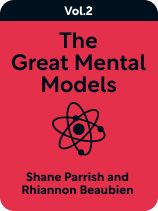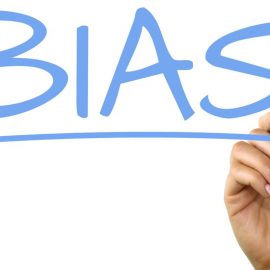

This article is an excerpt from the Shortform book guide to "The Great Mental Models Volume 2" by Shane Parrish and Rhiannon Beaubien. Shortform has the world's best summaries and analyses of books you should be reading.
Like this article? Sign up for a free trial here.
Do you struggle to make changes in your life? Should you be a generalist or a specialist? What’s the benefit of understanding other people?
The Great Mental Models Volume 2: Physics, Chemistry, and Biology shows how certain scientific principles can be applied personally, professionally, and socially. The authors Rhiannon Beaubien and Shane Parrish use models from these disciplines to understand things such as progress, competition, and relationships.
Keep reading for an overview of this fascinating book.
Overview of The Great Mental Models Volume 2
The Great Mental Models Volume 2: Physics, Chemistry, and Biology is the second in a series of books designed to help you improve your thinking by giving you a set of rules and patterns (“models”) that occur again and again in many different contexts. The premise of the series is that if you internalize these models, you can cut through complexity and uncertainty in order to understand the world and make better decisions. This book, Volume 2, discusses models drawn from the sciences—physics, chemistry, and biology—and focuses on ideas that can help you understand personal and social change as well as competitive environments such as business.
The Great Mental Models book series builds on a list of mental models first published on Farnam Street (FS), a website and blog dedicated to the pursuit of wisdom and better thinking. Volume 1 introduces the series and presents a set of foundational models, while Volume 3 discusses ideas drawn from systems theory and mathematics. Volume 2 was written by Rhiannon Beaubien and Shane Parrish, both former Canadian intelligence agents and the content strategist and founder (respectively) of FS.
Volume 2 dedicates a chapter to each model it discusses and groups its chapters around the fields of physics, chemistry, and biology. In this guide, we’ve condensed and reorganized the models around three major themes:
- Movement and change—models that explain the challenges of making progress in our own lives and on a social level.
- Interpersonal interaction—models that suggest more effective ways to work with those around us.
- Surviving and thriving—models that offer ideas for competing more effectively and adapting to our changing circumstances.
As we explore each theme, we elaborate on Beaubien and Parrish’s models by tying in related ideas and showing you how to put the book’s models into practice.
Part 1: Movement and Change
One of the main themes in The Great Mental Models Volume 2 is that both change and movement are difficult. The laws of physics dictate that setting an object in motion, keeping it in motion, and suddenly stopping or redirecting its motion all require a significant application of energy. By analogy, these laws help explain why it’s so hard to make changes in our own lives and in our social systems. The authors suggest that, by understanding these forces, we can apply our energy more efficiently to get the results we want.
Why Change Is Hard: Inertia, Momentum, & Friction
One reason we struggle with change is that, like physical objects, our lives are subject to inertia—a physical principle by which objects resist changes to their state of motion or rest. Similarly, the principle of momentum describes the tendency of a moving object to stay in motion. We could say that the heavier something is and the faster it’s already moving, the harder it is to stop.
Beaubien and Parrish argue that the concepts of inertia and momentum apply to our efforts to change things in our lives. For example, the principle of inertia makes it hard to start a new behavior. On the other hand, the authors point out that momentum can be both a help and a hindrance to behavior change. Habits are like a boulder—once it’s rolling, it’s hard to stop.
Moreover, inertia and momentum don’t apply to just individual behaviors—Beaubien and Parrish argue that these concepts help explain why it can be hard to institute social change and why certain policies and practices stick around even when they’re harmful.
Beaubien and Parrish point out that, when it comes to movement, objects aren’t affected by just their own properties of inertia and momentum—they’re also affected by external forces like friction. Similarly, the authors suggest, it’s worth paying attention to the external factors that slow us down so that we can create conditions more conducive to progress.
In physics, friction is a force that resists movement. Beaubien and Parrish argue that understanding the principle of friction lets us develop more efficient organizations by eliminating the factors that slow movement.
Making Change Easier: Incentives & Catalysts
Beaubien and Parrish explain that, when we’re aiming for change on a personal or social level, it’s crucial to understand incentives—the factors that shape our behaviors by rewarding or punishing them. Though incentives are key to survival, Beaubien and Parrish point out that they frequently go wrong. For one thing, many behaviors have short-term and long-term consequences—and, if we don’t notice the long-term consequences, we have a hard time making the best choices. Similarly, Beaubien and Parrish point out that poorly designed incentives can lead to undesirable behavior.
In short, Beaubien and Parrish suggest that you should be cautious about incentives—take a close look at what’s motivating your behavior and determine whether that motivation lines up with your long-term goals and values.
Whereas incentives can help you direct behaviors to initiate change, Beaubien and Parrish argue that catalysts can accelerate change at the social level. They explain that, in chemistry, a catalyst is a substance that increases the rate of a chemical reaction without being consumed itself by the reaction.
Beaubien and Parrish argue that chemical catalysts are metaphors for factors that accelerate social change. For example, some technologies work as catalysts by offering new ways of spreading ideas and mobilizing them into action. Likewise, Beaubien and Parrish say that influential people can serve as catalysts by making new ideas or behaviors more attractive by association.
As Beaubien and Parrish point out, social catalysts don’t cause change that wouldn’t have happened otherwise—instead, they accelerate change that’s already underway.
Part 2: Interpersonal Interaction
One of Beaubien and Parrish’s recurring ideas is that the world consists of systems that depend on the interaction of all their components.
We’re Stronger Together: Alloying & Cooperation
One reason to work collaboratively with others is that combining forces enhances our capabilities. Beaubien and Parrish explain this concept through the model of alloying. In chemistry, an alloy is a combination of a metal and at least one other substance. Alloys enhance the base metal by adding new properties that make the alloyed metal more useful. Beaubien and Parrish argue that, in a human context, alloying describes the way people can combine their strengths to accomplish things that neither person could accomplish alone.
Beaubien and Parrish point out that another benefit of working with others is that, in addition to complementing your skills, other people can supplement your knowledge and strengthen your understanding of the world.
Whereas alloying shows the power of uniting toward a common goal, the model of cooperation shows how two parties can utilize reciprocity by aligning their actions to benefit each other—even as they pursue individual interests. Beaubien and Parrish illustrate this principle with the biological phenomenon of symbiosis, which shows how cooperation lets individuals align their purposes for mutual gain.
In biology, symbiosis refers to a mutually beneficial relationship between two different species that live in close proximity. Beaubien and Parrish point out that similar forms of cooperation exist within the human world, often in the realm of business. Cooperative business models (such as Etsy) demonstrate the power of Beaubien and Parrish’s suggestion to think about what you can offer others, not just what they can offer you—often, by helping others, you help yourself as well.
Understanding Others: Relativity & Leverage
To work with other people effectively, you should keep in mind that everyone sees the world differently. That’s the basis of Beaubien and Parrish’s model of relativity—the idea that our understanding of a situation depends on our perspective. They explain that, in physics, Einstein’s theories of relativity established that there’s no fixed frame of reference when observing physical phenomena—our perception of movement, distance, and time itself are dependent on our own position and speed relative to the event we’re observing.
Relativity reminds us that no one’s account of the world is objectively true—everything we know or think we know is colored by subjective factors such as bias, limited perspective, and faulty memory. Because subjectivity is unavoidable, Beaubien and Parrish argue that it’s important to accept and appreciate other people’s points of view.
Whereas relativity helps us understand where other people are coming from, Beaubien and Parrish point out that, once you know what other people want and need, you can use the model of leverage to help you get what you want.
In physics, leverage refers to the use of a lever, a simple machine consisting of a rod or plank rotating around a fixed point. Levers multiply the force you apply to them, allowing you to lift or move things you couldn’t lift on your own. In a social situation, having leverage means having a way to get what you want without applying large amounts of force. Beaubien and Parrish explain that leverage results from having something that other people want or need. The more they need it—and the less you need from them—the more leverage you have.
Beaubien and Parrish say, leverage isn’t about pushing other people around—it’s about understanding where they’re coming from and figuring out how to make your offer as attractive to them as possible. They acknowledge that it’s possible to use leverage to exploit others—though they warn that doing so ultimately undermines your position by teaching others not to trust you. Therefore, they suggest that if you want to keep your leverage, you should not push it too far.
Part 3: Surviving and Thriving
Drawing mostly from biology and the theory of evolution, we’ll finish by exploring some of the models that, according to the authors, suggest ideas about how to survive and get ahead in a competitive world. These ideas are particularly relevant in the business world, but many of the lessons also apply more broadly to life as a whole.
Competition: The Red Queen Effect, Adaptation, & Exaptation
The Red Queen effect states that evolution is an ongoing process and species must constantly adapt to competitive pressures or else be killed off. Similarly, if an idea or technology can’t keep up with changing needs, it’ll die off in favor of more useful or flexible alternatives. Beaubien and Parrish suggest that the Red Queen effect is particularly useful when considering business strategy, where this concept warns that, just because a product or business model has been successful for a long time doesn’t mean it will continue to thrive.
Although the Red Queen effect suggests the importance of constantly evolving, it doesn’t actually explain how to do it. Luckily, Beaubien and Parrish introduce the ideas of adaptation and exaptation to explain how you can keep up in a competitive environment.
In evolutionary biology, an adaptation is a new structure that arises to serve a specific function. In a technological context, adaptation is a straightforward idea—it means coming up with new products and strategies to bring in money. The trick, as we saw with the Red Queen effect, is to keep innovating to stay ahead of your competitors.
Whereas biological adaptation requires developing a new structure for a specific purpose, an exaptation is the use of an existing structure for a new purpose. Beaubien and Parrish argue that, in the human world, exaptation suggests that, instead of inventing new technologies, you can be equally successful by finding new uses for existing ones. They point out that exaptation also means that you can create new technologies without necessarily knowing what they’ll be used for.
Finding Your Way: Niches & Velocity
Beaubien and Parrish argue that, if you want to thrive, you should find your niche—a specific role in the social environment that lets you capitalize on your strengths and maximize your chances of success. The authors argue that, to find the right niche, you should decide whether to be a generalist or a specialist. In biology, a niche refers to the function a species fulfills within its ecosystem. In this context, a generalist (like a raccoon) is a species that lives in a range of conditions and eats a variety of foods, whereas a specialist (like a koala) requires a specific habitat or food source.
Generalist businesses face fierce competition from other generalists in the same niche, but they’re also unlikely to go out of business as cultures and economies change. Specialist businesses can dominate their small market niches, but they’re vulnerable to technological and cultural changes that alter that niche. In short, Beaubien and Parrish point out that generalizing and specializing both have their strengths and weaknesses—rather than promoting one over the other, they suggest learning which one best suits you so that you can strategize appropriately.
Once you know where you want to be (for example, which niche you want to fill), you still have to figure out how to get there. That’s why Beaubien and Parrish offer the model of velocity—which suggests the importance of knowing where you’re going and not just how quickly you’re moving. Velocity is an object’s rate of movement in a designated direction.
Velocity reminds us to choose our direction carefully to make sure we end up where we want to go. It’s entirely possible to spend all of your time and energy working hard (gaining speed) without actually moving closer to your goals.
Exercise: Use the Mental Models to Make a Change
The Great Mental Models series is designed to provide useful tools for everyday life. Let’s explore how you can use some of the models from Volume 2 to make a meaningful change in your life.
- Describe a problem you’re facing or a change you’d like to make in your life. Name some specific factors that are holding you back through friction and/or inertia.
- What incentives could you use to motivate your progress? What catalysts could make your job easier?
- Name someone who could help you toward your goal. How would you alloy or cooperate with this person to advance your aims? How could you use relativity or leverage to get that person on your side?
- How would you measure your progress toward your goal to make sure you maintain velocity in the right direction?

———End of Preview———
Like what you just read? Read the rest of the world's best book summary and analysis of Shane Parrish and Rhiannon Beaubien's "The Great Mental Models Volume 2" at Shortform.
Here's what you'll find in our full The Great Mental Models Volume 2 summary:
- How you can understand anything by learning a finite set of rules and patterns
- How physics can help you improve interpersonal interactions
- Why making a major life change is so difficult






